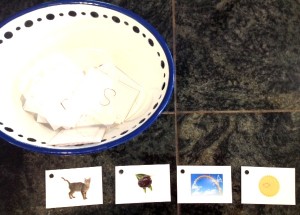My little Bunny Boo is about 1/2 way through kindergarten, and we are using Teach Your Child to Read in 100 Easy Lessons as her introduction to reading. We have mixed feelings about this reading approach, as it seemed very slow and tedious for very bright children. With our first, we ditched the book after about a week of it and just went straight to 1st grade Rod and Staff language arts curriculum. That worked well for her, as she is a mature, advanced student in general. My second HATED the Teach Your Child to Read approach until he was 5 years old, and then we used it until lesson 50, at which point, already knowing his letters and sounds, he started, and excelled at, Rod and Staff 1st grade language arts.
Enter my Bunny Boo. She is very different from my older two in that she does not have the attention span or desire to learn to read that motivated them. She is the third, the spoiled, babied, beautiful, tiny baby girl, and she is creative beyond belief. She wants to be a kitten and an princess all day long while creating art projects, playing with dolls, and letting everyone else pamper her. And we all happily pamper her. After all, she is the cheeriest, cutest, most precious little 3rd child that ever lived. But she is 5, and she is almost finished with her kindergarten math curriculum, and so it is time to move the reading along. So we pulled out Teach Your Child to Read. She LOVES it! However, Bunny Boo is not the kind of kid who cares to remember little things like what sound the letter i makes. By lesson 20, I was about to blow my brains out. She came to the lessons with the most cheerful, compliant attitude, but as she read the words, she could not remember ANY of the sounds except S and M. We looked at the letters over and over and over again, and still, no dice. She could NOT remember the letter sounds from one day to the next! But we soldiered on, and I was confident that one day it would stick.
And then it happened. I blithely suggested that we backtrack several lessons so we could work a little more on those tricky letters. My Bunny Boo cried and said she was not smart. Hardly anything can make my sunny baby cry, so I knew we had to do something different. I asked her if she wanted to put reading aside for a few months and try again later. Her little determined look and adamant NO eliminated that option. So I dug into my bag of tricks and remembered a man I worked with waaaaayyyyyyy back when I was doing my Level 2 occupational therapy schooling and working with a man who had experienced a stroke and some pretty horrible memory loss with respect to word finding and pairing a word with the correct object. In OT school you learn about memory pegs and re-learning lost skills while performing appropriate life tasks. People rehabilitate while going about their daily lives. This is why games are so important for kids who have trouble learning something. It is a kids job in life to play. It is how they learn. My Bunny Boo is a master of play!
So I made up some cards. I looked online for pictures my Bunny Boo would like and printed a picture for each sound she was learning as well as 10 corresponding letter cards for each picture. So for the picture of a cat, I printed 10 C cards, for the picture of a sun, I printed 10 S cards, and so on. Then I laminated them and cut them out. I used the 1.5×2.5 inch cards from Lakeshore so I could keep them on a ring and organized (I will end up with over 250 cards in the end, maybe more!).
Here is how the games are played:
Game 1 (easiest – 2+ players – no winner):
1. Separate out the letter sounds and corresponding pictures you would like to work on. I would use a minimum of 3 different sounds for a game.
2. Toss the letter cards into a bowl and mix them up.
3. Lay out the picture cards so that you have enough space to stack the corresponding letter cards under each picture card (if you make more than one row of picture cards).
4. Taking turns, draw a card from the bowl, say the sound on the card, and place the letter card below the corresponding picture.
5. Play until all cards have been used up.
Game 2 (easy – 2+ players – no winner):
Play as you would play Game 1, but turn the cards face down below the corresponding pictures so the letter is not showing. In this version, there is no cue to search for when trying to place a card or remember the sound.
Game 3 (harder – 2+ players – there is a winner!) sort of like memory:
1. Each player chooses one or more pictures and lays it/them out in front of him. Your child should choose the pictures for the sounds that are currently difficult.
2. Lay the sound cards corresponding to the chosen pictures out, face down, in rows. You can use as many of the sound cards as you want. You do not have to use all 10 for each picture card. You can use, say, 4 of each, if you just need to review rather than really learn the sounds. The game can work with any even number. Just make sure you use the same number of sound cards for each chosen picture.
3. The first player turns over 2 cards. If either of the cards match that players chosen picture, the player gets to place that card under the picture.
4. If the player finds a card matching one of his pictures, he gets to go again. If he does not, play passes to the next person.
5. Play until all the cards have been picked up. Whoever finds all the cards for all of his chosen pictures first is the winner.
Game 4 (even harder – 2+ players – there is a winner!) this is more like memory:
1. Each player chooses one or more pictures and lays it/them out in front of him. Your child should choose the pictures for the sounds that are currently difficult.
2. Lay the sound cards corresponding to the chosen pictures out, face down, in rows. You can use as many of the sound cards as you want. You do not have to use all 10 for each picture card. You can use, say, 4 of each, if you just need to review rather than really learn the sounds. The game can work with any even number. Just make sure you use the same number of sound cards for each chosen picture.
3. The first player turns over 2 cards. If the cards match each other AND match one of the picture cards, the player gets to keep the pair and place them under the picture card face up.
4. If a player finds a pair matching one of his pictures, he gets to go again. If he does not, play passes to the next person.
5. Play until all the cards have been picked up. Whoever finds all the cards for all of his chosen pictures first is the winner.
Game 5 (hardest – 2+ players – there is a winner!) If you are playing this version, your child should not need to be cued as to what the sounds are on the cards. Do not play this version until he is at that point. This game is simply for reviewing and solidifying known sounds in a fun way.
1. Choose 11 or more picture cards (an odd number of them) and ONE corresponding sound card.
2. Lay out the cards face down.
3. The first person turns over 2 cards. If it is a picture card with a matching sound, the player gets to go again. If the sound and the picture card do not match, play passes to the next person.
4. Play until all the cards have been picked up. Whoever has the most pairs at the end is the winner.
So there you have it. This worked for us after one game. Bunny Boo learned the sounds to the 12 letters she was working in by lesson 25, and we will just add cards as we go. She has not cried since. 🙂





Recent Comments